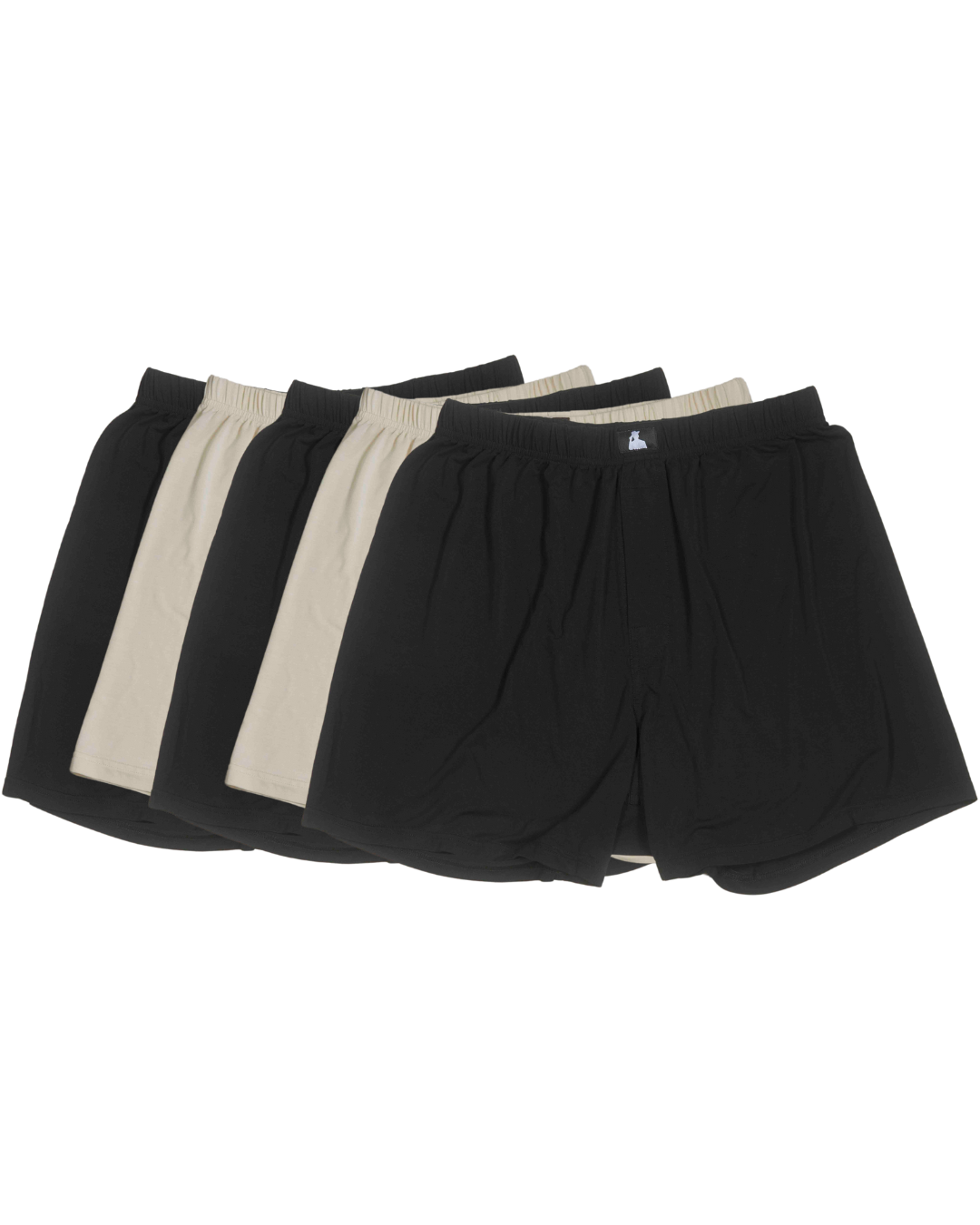Fertility Underwear: What It Is and Why It’s Essential for Reproductive Health
Written By The Mr. Fertyl Research & Education Team
Male fertility is surprisingly sensitive to everyday factors - even what we wear under our clothes. While it might seem trivial, underwear matters for sperm health. Our testes sit outside the body in the scrotum for a reason: sperm develop best at slightly cooler-than-body temperature [1]. Modern underwear comes in many styles and fabrics, and not all are created equal for reproductive health. “Fertility underwear” is simply underwear designed to maximize sperm health by keeping the scrotal environment cool, dry, and free of harmful chemicals. Unlike conventional briefs or synthetic blends, fertility underwear uses ultra-breathable, natural fabrics (like Bamboo-derived Lyocell) and looser cuts to prevent overheating. In other words, it’s underwear engineered for comfort and reproduction.
Tight briefs or synthetic fabrics can raise scrotal temperature and even expose skin to chemical additives [1][2]. For example, Mayo Clinic notes that anything overheating the testicles (such as long laptop use, tight clothing, or hot tubs) may impair sperm production [1]. Although studies on boxers-versus-briefs alone are mixed, researchers generally advise men to avoid prolonged heat exposure. One Mayo Clinic review found that frequent hot baths or saunas can lower sperm counts for months [4]. Similarly, tight garments or synthetic pants can trap heat. In fact, wearing restrictive underwear or sitting in warm environments can subtly bump up scrotal temperature, which (even if not conclusively proven to cause infertility) is best avoided if you’re planning to conceive [1].
Studies reinforce this: in a fertility-clinic study of 656 men, those who primarily wore boxers (a loose style) had significantly higher sperm counts and motility than men who didn’t [4]. Boxer-wearers showed about 17% higher total sperm count (and 33% more total motile sperm) compared to men in tighter underwear [4]. The pattern suggests that even modest increases in scrotal heat from tight briefs or synthetic materials can impact sperm quantity and quality. (However, researchers note that sperm production often rebounds once the source of heat is removed [5].) In practice, these findings mean something as simple as switching to breathable cotton or bamboo underwear could make a difference.
Risks of Synthetic Fabrics and Chemicals
Beyond temperature, the materials and chemicals in underwear can affect male reproductive health. Synthetic fibers like polyester and nylon and their dyes often contain additives (phthalates, flame retardants, formaldehyde, etc.) that disrupt the endocrine system – our body’s hormone network [2][6]. For example, polyester tends to generate static electricity and trap heat. In a classic experiment, dogs forced to wear polyester underwear for two years developed dramatically lower sperm counts and more sperm defects, compared to dogs in cotton (with changes reversing after stopping polyester) [5]. The researchers suggested that polyester’s electrostatic properties (and perhaps heat trapping) may have harmed sperm production [5]. While human studies are limited, the animal data are a red flag.
Many chemical dyes and finishes used in clothing are also worrisome. Vibrant synthetic dyes can off-gas or leach substances against the skin, and some have been shown to cause skin irritation or even affect reproductive health. Investigators have found certain textile dyes linked to “reproductive toxicity” in lab studies [7]. Another concern is phthalates – plasticizers used in many industrial processes. Phthalates have been detected in fabrics, especially prints or stretch materials, and are known as endocrine disruptors. Research shows phthalates can mimic hormones and have been tied to lower testosterone and sperm quality in animal studies [2][8]. In humans, higher phthalate levels in men have been associated with decreased semen quality and hormone imbalances (though evidence in men is still emerging) [2][8]. In short, daily skin contact with synthetic fibers or chemical finishes could be nudging hormone levels out of balance.
Key risks from conventional underwear:
- Heat & Trapping: Synthetic blends and tight fits can increase scrotal temperature, which impairs sperm count [1].
- Chemical Exposure: Many polyester, nylon, and stretch fabrics contain phthalates, dyes, BPA or flame retardants – all known endocrine disruptors [2][7].
- Skin & Comfort: Cheap polyester and nylon can bind sweat and irritate sensitive skin, leading to infection risks and discomfort.
By contrast, underwear made from natural, breathable fibers avoids many of these issues. Fabrics like bamboo and linen don’t carry the same endocrine-disrupting chemicals and tend to be much more moisture-wicking and gentle on the skin. Choosing natural materials can help keep the scrotum cool and dry, exactly the environment healthy sperm need [1][4].

Hot Underwear. Low Sperm.
Keep Your Swimmers SafeHow Fertility-Friendly Materials Help
What makes a fabric “fertility-friendly”? First and foremost, breathability and moisture control. Materials like Bamboo Lyocell and organic cotton allow air to circulate, wicking sweat away so heat doesn’t build up. In fact, lyocell fibers (often branded as TENCEL™) can absorb 50% more moisture than cotton, keeping the skin drier and cooler. Bamboo Lyocell is also naturally hypoallergenic and ultra-soft, reducing friction or irritation. A smooth, breathable fabric won’t trap heat or chafe the delicate skin around the scrotum.
Second, quality fertility underwear is made without harmful chemicals. For example, OEKO-TEX® Standard 100 certification (common on trusted brands) guarantees that the fabric has been tested against over a thousand harmful substances [9]. In practical terms, OEKO-TEX® means no nasty dye residues, formaldehyde, or heavy metals are in the garment. An OEKO-TEX® certified Bamboo Lyocell boxer is essentially “zero-toxin”: every fiber, button, and thread meets strict human-ecology standards [9]. That gives you peace of mind that nothing in the underwear is bio-accumulating or affecting your hormones.
Third, certain fibers have unique properties: Bamboo Lyocell is naturally anti-bacterial due to its moisture management. That means better odor control and fewer growths on hot days. It’s also sustainable – bamboo grows fast without pesticides, making it an eco-conscious choice. In short, fertility underwear uses fabrics that doctors and researchers praise: materials that keep the scrotum cool, clean, and chemical-free.
Fertility Underwear vs. Conventional Underwear
To recap, fertility underwear stands out in three main ways:
- Fit & Support: A roomier pouch or boxer style that reduces compression. Loose-fitting designs naturally keep testicles a bit lower and farther from body heat [3][4].
- Breathable Fabric: 100% natural fibers (like Bamboo Lyocell, cotton) that wick moisture and ventilate, rather than cling with sweat [1].
- Chemical-Safe: Certified safe fabrics. No synthetic plasticizers, azo-dyes, flame retardants, etc. The garment itself meets OEKO-TEX® or similar standards [9].
For example, an all-cotton pair of boxers is already better than cheap polyester briefs. But Bamboo Lyocell goes a step further: it’s naturally thermo regulating – cooling you down when it’s hot and insulating when it’s cold – while staying incredibly soft. Think of it as high-performance underwear built on comfort science. In practice, switching from tight polyester briefs to a pair of Bamboo Lyocell boxers can reduce scrotal temperature by a fraction of a degree and eliminate exposure to hormone-mimicking chemicals. Over time, that small change could add up to noticeably healthier sperm parameters.
Why It Matters
Normalizing fertility means paying attention to often-overlooked details. Underwear is one such detail. It’s not a magic cure, but a simple lifestyle tweak. Male infertility rates have been rising globally, and environmental factors (from chemicals to heat) are major suspects [10]. While you don’t need to panic about every T-shirt or sitting habit, choosing fertility-aware underwear is a no risk choice with potential upside. Think of it like wearing sunscreen on a cloudy day – a precaution that can keep small harms from accumulating.
The science backs it up: elevated testicular temperature is known to lower sperm count [1], and endocrine disruptors have been linked to reduced sperm quality [2][8]. By contrast, keeping your bits cool, dry, and free of toxins is aligned with every doctor’s tip for healthy sperm. It’s a bit like eating a balanced diet or exercising – you may not see the payoff tomorrow, but it stacks the deck in your favor. In short, fertility underwear is about empowerment: giving men one more easy way to optimize their reproductive health.
Choosing Mr. Fertyl’s Bamboo Lyocell Underwear
If you’re convinced that underwear can make a difference, it’s natural to wonder what to choose. Enter Mr. Fertyl’s line of Bamboo Lyocell boxer briefs. These are crafted with all the “fertility-friendly” traits: a relaxed, ergonomic pouch design, ultra breathable Bamboo Lyocell fabric, and OEKO-TEX® Standard 100 certification to ensure there are zero harmful chemical residues [9]. The bamboo fibers wick moisture better than cotton, and the smooth stretch waist stays snug without squeezing. In our experience and testing, wearers report feeling noticeably cooler and more comfortable throughout the day (no sticky sweat or irritation).
Beyond comfort, Mr. Fertyl’s underwear is a health product. By switching to our Bamboo Lyocell underwear, you’re not just buying soft boxers - you’re choosing a garment designed to respect your endocrine system and keep the temperature ideal for sperm production [1][9]. In essence, it’s underwear that looks out for your reproductive health in the background, while still functioning as everyday gear.
Finally, this choice aligns with broader environmental health concerns. Bamboo is a rapidly renewable resource and the closed-loop lyocell process recycles all solvents, making it sustainable and biodegradable. So Mr. Fertyl’s approach marries personal health with planet-friendly materials. It’s a subtle shift: changing your underwear to protect both your sperm and the world around you.

Tight, Synthetic, Sweaty?
Explore Bamboo BenefitsConclusion
Talking about male fertility doesn’t have to be awkward or taboo. It’s a health topic like any other. Fertility underwear gives men a tangible way to be proactive: it’s combining common-sense lifestyle advice (stay cool, avoid toxins) with an easy product switch. The science suggests that keeping testicles cool and chemical-free can only help sperm health [1][8], so why not make that part of your routine?
If you’re looking to make a small change with big peace-of-mind benefits, consider trying fertility-friendly underwear. In particular, Mr. Fertyl’s Bamboo Lyocell collection offers the very qualities experts recommend – breathability, natural softness, and rigorous toxin testing [6][9]. Wearing these feels just like wearing quality boxers, but with an extra layer of health-conscious design. After all, it’s not just about feeling good in the moment; it’s about supporting your reproductive health for the future.
Regular cotton or polyester underwear isn’t bad, but if you’re planning for kids (or even just want to stay on the safe side), upgrading to fertility underwear is an easy, evidence-based choice [1][4]. You’ll get superior comfort and potentially healthier sperm – a combination worth having.
- Mayo Clinic Staff. (2022). Male infertility: Symptoms and causes. Mayo Clinic. Source.
- Wang, Y., & Qian, H. (2021). Phthalates and their impacts on human health. Healthcare, 9(5), 603. Source.
- Ogle, A. (2019). Boxers or briefs? 4 common fertility myths debunked. Mayo Clinic Health System. Source.
- Mínguez-Alarcón, L., Gaskins, A. J., Chiu, Y.-H., Messerlian, C., Williams, P. L., Ford, J. B., Souter, I., Hauser, R., & Chavarro, J. E. (2018). Type of underwear worn and markers of testicular function among men attending a fertility center. Human Reproduction, 33(9), 1749–1756. Source.
- Shafik, A. (1993). Effect of different types of textile fabric on spermatogenesis: an experimental study. Urological Research, 21(5), 367–370. Source.
- National Institute of Environmental Health Sciences. (n.d.). Endocrine disruptors and your health. NIEHS. Source.
- Wicker, A. (2023). Are your clothes making you sick? The opaque world of chemicals in fashion. The Guardian. Source.
- Endocrine Society. (n.d.). Endocrine-disrupting chemicals (EDCs). Endocrine Society. Source.
- OEKO-TEX®. (n.d.). OEKO-TEX® STANDARD 100. OEKO-TEX®. Source.
- National Library of Medicine. (2022). Sperm counts may be declining... (CNN News) - Behind the headlines. Source

